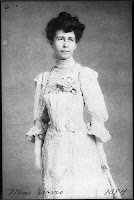A Mother for a Whole Community
Today I would like to look at the story of the origins of the celebration of Mother’s Day in the United States in the context of the life of the woman who succeeded in getting it designated as a national observance. But the origins of this observance had nothing to do with sending flowers and enriching the floral industry or sentimental cards and enriching the greeting card industry. It had to do with recognizing and honoring the tireless work of women in trying to improve conditions for people in their local communities and families.
[Anna Jarvis, daughter of Ann Marie Reeves Jarvis]
The Civil War provided the impetus behind the work of Ann Marie Reeves Jarvis, the mother of Anna Jarvis, who is credited with working to establish Mother’s Day as a National Commemoration of the work of mothers for the betterment of their communities and families. Ann, her husband Granville, and their children lived in Grafton, Taylore County, West Virgina. Ann was the daughter of a Methodist minister, and her husband Granville was the son of a Baptist pastor. The following information was researched from a site on the Internet that no longer exists. However the information contained in it was derived from two books that can still be found in libraries:
Ann was the mother of eleven children, but only four lived to adulthood. In spite of the large family and the tragedies that occurred, Mrs. Jarvis was active in church and civic affairs. Most remarkable was the work she did to combat poor health and sanitation conditions that existed in Webster and in many other neighborhoods, and which attributed to the high mortality rate of children. After eight years of marriage, at the age of twenty-six, the young housewife and mother sprang into action to combat these conditions and called on all women in Webster, Philippi, Pruntytown, Fetterman and Grafton to meet at local churches where she organized clubs, known as Mothers Day Work Clubs…. The clubs furnished women to care for families with tubercular mothers, medicine was provided for the indigent, and milk for children was inspected. The clubs were honored for successfully carrying out their plans and solving a local community problem.
In 1861, another need for the Mothers Day Work Clubs was pending. After both Lee and McClellan gave orders to hold the Grafton railroad terminus at all costs, much of Taylor County, including the community of Webster, soon became an armed camp of both Union and Confederates. Mrs. Jarvis quickly sensed possible disruption in the clubs and called an urgent meeting, The group heard Mrs. Jarvis objectives: "To make a sworn-to agreement between members that friendship and good will should obtain in the clubs for the duration and aftermath of the war. That all efforts to divide the churches and lodges should not only be frowned upon but prevented."
When an epidemic of typhoid fever and measles broke out among the military personnel, Mrs. Jarvis and her Mothers Day Work Clubs were called upon for help. Her answer was "You shall have it. .. No mistreatment of any of our members. We are composed of both the Blue and the Gray." The clubs subsequently received the highest commendations from officers and soldiers for the magnificent services rendered the sick soldiers.
After the Civil War, public officials sought a way to alleviate post-war strife, and once more Mrs. Jarvis was called upon to help. She rallied the members of her clubs to meet at the Pruntytown Courthouse, and there they planned a "Mothers Friendship Day" to be held in Pruntytown, the county seat. The members were to invite all soldiers, Blue and Gray, and their families. An immense crowd arrived on the designated day. When the program started, Mrs. Jarvis appeared dressed in gray, and another women appeared dressed in blue. Two teenage girls assembled with the Pruntytown band on the courthouse porch, and a bugler called the crowd to assemble. Mrs. Jarvis explained the purpose of Mothers Friendship Day and asked the band to lead them in singing Way Down South in Dixie. The lady in blue then asked the band to lead her and the audience in singing The Star Spangled Banner. Cheering and laughter followed, the two young girls took the hands of Mrs. Jarvis and the lady in blue and asked them to shake hands and hug each other. They then called on the crowd to do the same thing while band played Should Auld Acquaintance Be Forgot. By the time the song was over, it seemed that everyone began to weep and shake hands.
(Sources: Norman F. Kendall, Mothers Day, A History of its Founding and its Founder, 1937; Howard H. Wolfe, Mothers Day and the Mothers Day Church, 1962 . Taken from the website: The Mother of Mothers Day http://www.rootsweb.com/~wvtaylor/mother.htm. Note: this link is no longer active.)
Tomorrow: More on Anna Marie Jarvis and her efforts to honor the work of her mother and other mothers.
For further reading:
Ruth Rosen argues for a return to the peace-making roots of Mothers Day: http://www.slate.com/id/2217890
(Images: Anna Jarvis from http://www.the-parenting-magazine.com/wp-content/uploads/2009/05/anna-jarvis.jpg; http://water1st.org/waterlog/wp-content/uploads/2009/05/anna-jarvis.jpg; Ann Marie Reeves Jarvis from http://www.wvgenweb.org/taylor/images/annmarie.gif)





Comments
Post a Comment